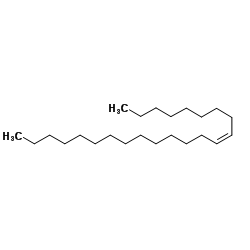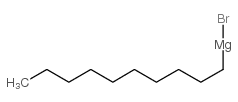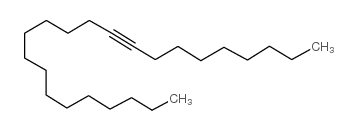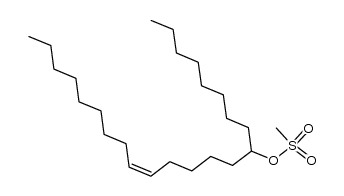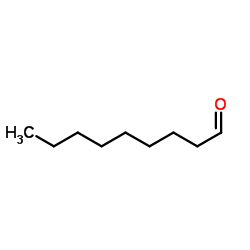27519-02-4
| 中文名 | 诱虫烯 |
|---|---|
| 英文名 | muscalure |
| 中文别名 |
顺-9-二十三烯
(Z)-9-二十三碳烯 顺式-9-二十三烯 順-二十三碳-9-烯 |
| 英文别名 |
EINECS 248-505-7
(9Z)-Tricos-9-ene cis-tricos-9-ene MUSCAMONE Tricosene cis-9-Tricosene (9Z)-9-Tricosene tricos-9c-ene 9-Tricosene, (9Z)- MUSCALURE MFCD00008988 FLYBAIT (Z)-tricos-9-ene (9Z)-Tricos-9-en cis-9-Tricosene,Muscalure |
| 描述 | (Z) -9-三碳烯(顺-9-ricosene)是一种昆虫信息素,存在于直翅目苍蝇(如家蝇)中,可作为杀虫剂[1]。 |
|---|---|
| 相关类别 | |
| 参考文献 |
| 密度 | 0.8±0.1 g/cm3 |
|---|---|
| 沸点 | 399.4±9.0 °C at 760 mmHg |
| 分子式 | C23H46 |
| 分子量 | 322.61 |
| 闪点 | 208.8±9.7 °C |
| 精确质量 | 322.359955 |
| LogP | 12.46 |
| 外观性状 | 无色至琥珀色棕色油状 |
| 蒸汽压 | 0.0±0.4 mmHg at 25°C |
| 折射率 | 1.453 |
| 储存条件 | 保持贮藏器密封 放入紧密的贮藏器内,储存在阴凉,干燥的地方 |
| 稳定性 | 1. 如果遵照规格使用和储存则不会分解 2. 避免接触氧化物 3. 存在于烟气中。 |
| 分子结构 | 1、 摩尔折射率:108.66 2、 摩尔体积(cm3/mol):401.8 3、 等张比容(90.2K):934.4 4、 表面张力(dyne/cm):29.2 5、 极化率(10-24cm3):43.07 |
| 计算化学 | 1、 疏水参数计算参考值(XlogP):11.7 2、 氢键供体数量:0 3、 氢键受体数量:0 4、 可旋转化学键数量:19 5、 拓扑分子极性表面积(TPSA):0 6、 重原子数:23 7、 表面电荷:0 8、 复杂度:216 9、 同位素原子数量:0 10、 确定原子立构中心数量:0 11、 不确定原子立构中心数量:0 12、 确定化学键立构中心数量:1 13、 不确定化学键立构中心数量:0 14、 共价键单元数量:1 |
| 更多 | 1. 性状:未确定 2. 密度(g/mL,25/4℃):0.806 3. 相对蒸汽密度(g/mL,空气=1):未确定 4. 熔点(ºC):未确定 5. 沸点(ºC,常压):300 6. 沸点(ºC,5.2kPa):未确定 7. 折射率(n20D) :1.453 8. 闪点(ºF):>110 9. 比旋光度(º):未确定 10. 自燃点或引燃温度(ºC):未确定 11. 蒸气压(kpa,20ºC):未确定 12. 饱和蒸气压(kPa,60ºC):未确定 13. 燃烧热(KJ/mol):未确定 14. 临界温度(ºC):未确定 15. 临界压力(KPa):未确定 16. 油水(辛醇/水)分配系数的对数值:未确定 17. 爆炸上限(%,V/V):未确定 18. 爆炸下限(%,V/V):未确定 19. 溶解性:未确定 |
Synonym:Muscalure; (Z)-9-Tricosene; 9-Tricosene; 9-Tricosene, (Z)-; cis-Tricos-9-ene; Muscamone; Tricosen Section 2 - COMPOSITION, INFORMATION ON INGREDIENTS
Risk Phrases: None Listed. Section 3 - HAZARDS IDENTIFICATION EMERGENCY OVERVIEW
The toxicological properties of this material have not been fully investigated. Potential Health Effects Eye: May cause eye irritation. Skin: May cause skin irritation. Ingestion: May cause irritation of the digestive tract. The toxicological properties of this substance have not been fully investigated. Inhalation: May cause respiratory tract irritation. The toxicological properties of this substance have not been fully investigated. Chronic: No information found. Section 4 - FIRST AID MEASURES Eyes: Immediately flush eyes with plenty of water for at least 15 minutes, occasionally lifting the upper and lower eyelids. Get medical aid. Skin: Get medical aid. Flush skin with plenty of water for at least 15 minutes while removing contaminated clothing and shoes. Wash clothing before reuse. Ingestion: Never give anything by mouth to an unconscious person. Get medical aid. Do NOT induce vomiting. If conscious and alert, rinse mouth and drink 2-4 cupfuls of milk or water. Inhalation: Remove from exposure and move to fresh air immediately. If not breathing, give artificial respiration. If breathing is difficult, give oxygen. Get medical aid. Notes to Physician: Section 5 - FIRE FIGHTING MEASURES General Information: As in any fire, wear a self-contained breathing apparatus in pressure-demand, MSHA/NIOSH (approved or equivalent), and full protective gear. During a fire, irritating and highly toxic gases may be generated by thermal decomposition or combustion. Vapors may be heavier than air. They can spread along the ground and collect in low or confined areas. Extinguishing Media: Water may be ineffective. Use water spray, dry chemical, carbon dioxide, or appropriate foam. Section 6 - ACCIDENTAL RELEASE MEASURES General Information: Use proper personal protective equipment as indicated in Section 8. Spills/Leaks: Clean up spills immediately, observing precautions in the Protective Equipment section. Absorb spill using an absorbent, non-combustible material such as earth, sand, or vermiculite. Do not use combustible materials such as sawdust. Provide ventilation. Section 7 - HANDLING and STORAGE Handling: Wash thoroughly after handling. Remove contaminated clothing and wash before reuse. Use with adequate ventilation. Avoid contact with eyes, skin, and clothing. Keep container tightly closed. Avoid ingestion and inhalation. Storage: Store in a tightly closed container. Store in a cool, dry, well-ventilated area away from incompatible substances. Section 8 - EXPOSURE CONTROLS, PERSONAL PROTECTION Engineering Controls: Facilities storing or utilizing this material should be equipped with an eyewash facility and a safety shower. Use adequate ventilation to keep airborne concentrations low. Exposure Limits CAS# 27519-02-4: Personal Protective Equipment Eyes: Wear appropriate protective eyeglasses or chemical safety goggles as described by OSHA's eye and face protection regulations in 29 CFR 1910.133 or European Standard EN166. Skin: Wear appropriate protective gloves to prevent skin exposure. Clothing: Wear appropriate protective clothing to prevent skin exposure. Respirators: A respiratory protection program that meets OSHA's 29 CFR 1910.134 and ANSI Z88.2 requirements or European Standard EN 149 must be followed whenever workplace conditions warrant respirator use. Section 9 - PHYSICAL AND CHEMICAL PROPERTIES Physical State: Clear liquid Color: clear almost colorless Odor: None reported. pH: Not available. Vapor Pressure: Not available. Viscosity: Not available. Boiling Point: 300 deg C @ 760.00mmHg Freezing/Melting Point: Not available. Autoignition Temperature: Not applicable. Flash Point: > 110 deg C (> 230.00 deg F) Explosion Limits, lower: Not available. Explosion Limits, upper: Not available. Decomposition Temperature: Not available. Solubility in water: Not available. Specific Gravity/Density: .8060g/cm3 Molecular Formula: C23H46 Molecular Weight: 322.61 Section 10 - STABILITY AND REACTIVITY Chemical Stability: Stable under normal temperatures and pressures. Conditions to Avoid: Incompatible materials, strong oxidants. Incompatibilities with Other Materials: Oxidizing agents. Hazardous Decomposition Products: Carbon monoxide, carbon dioxide, acrid smoke and fumes. Hazardous Polymerization: Has not been reported. Section 11 - TOXICOLOGICAL INFORMATION RTECS#: CAS# 27519-02-4: YD0807000 LD50/LC50: CAS# 27519-02-4: Inhalation, rat: LC50 = >5 gm/m3; Oral, rat: LD50 = >5000 mg/kg; Skin, rabbit: LD50 = >2000 mg/kg. Carcinogenicity: cis-9-Tricosene - Not listed by ACGIH, IARC, or NTP. Other: See actual entry in RTECS for complete information. Section 12 - ECOLOGICAL INFORMATION Section 13 - DISPOSAL CONSIDERATIONS Dispose of in a manner consistent with federal, state, and local regulations. Section 14 - TRANSPORT INFORMATION IATA Not regulated as a hazardous material. IMO Not regulated as a hazardous material. RID/ADR Not regulated as a hazardous material. Section 15 - REGULATORY INFORMATION European/International Regulations European Labeling in Accordance with EC Directives Hazard Symbols: Not available. Risk Phrases: Safety Phrases: S 24/25 Avoid contact with skin and eyes. S 28A After contact with skin, wash immediately with plenty of water. S 37 Wear suitable gloves. S 45 In case of accident or if you feel unwell, seek medical advice immediately (show the label where possible). WGK (Water Danger/Protection) CAS# 27519-02-4: No information available. Canada CAS# 27519-02-4 is listed on Canada's NDSL List. CAS# 27519-02-4 is not listed on Canada's Ingredient Disclosure List. US FEDERAL TSCA CAS# 27519-02-4 is listed on the TSCA inventory. SECTION 16 - ADDITIONAL INFORMATION N/A |
|
毒理学数据: 急性毒性:大鼠口经LD50:>23070mg/kg;兔子皮肤LD50:>2025mg/kg 生态学数据: 通常来说对水是不危害的,若无政府许可,勿将材料排入周围环境 CHEMICAL IDENTIFICATION
HEALTH HAZARD DATAACUTE TOXICITY DATA
|
| 符号 |

GHS07 |
|---|---|
| 信号词 | Warning |
| 危害声明 | H317 |
| 警示性声明 | P280-P333 + P313 |
| 个人防护装备 | Eyeshields;Gloves |
| 危害码 (欧洲) | Xi: Irritant; |
| 风险声明 (欧洲) | R36/37/38 |
| 安全声明 (欧洲) | S24/25 |
| 危险品运输编码 | NONH for all modes of transport |
| WGK德国 | 2 |
| RTECS号 | YD0807000 |
| 包装等级 | II; III |
| 危险类别 | 4.1 |
| 海关编码 | 2901299010 |
| 上游产品 6 | |
|---|---|
| 下游产品 2 | |
| 海关编码 | 2901299010 |
|---|---|
| 中文概述 | HS: 2901299010 诱虫烯 增值税率:17.0% 退税率:9.0% 监管条件:S(进出口农药登记证明) 最低关税:2.0% 普通关税:30.0% |
| Summary | HS: 2901299010 cis-9-tricosene Educational tariff:17.0% Tax rebate rate:9.0% Regulatory conditions:S(Registration certificate of import and export) Lowest tariff:2.0% General tariff:30.0% |


